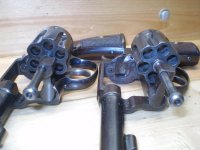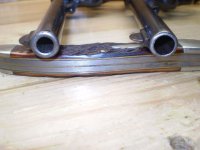I have a question for the experts on the older S&Ws:
We have all seen K frame 357 magnums and know that a steady diet of high pressure loads can have some effects on them if the end shake allow the cylinders to batter back and forth. But I read over and over how the higher pressure (rifle) loads for the old 32-20 is bad for S&W revolvers . I also understand that the 32-20 K frame guns had heat treating of the cylinders began with serial number 81287.
So, the pressure of a 357 Magnum run in the 36,000 PSI range but I only find pressures of the "rife load" 32-20 being 23,000 and the 32-20 chamber walls are a lot thicker then the walls on a 357 magnum. So can someone tell me why we are warned against using such loads in the K-frame guns when the 357 mags are obviously made for higher pressures then the 32-20 ever had and are fine despite the thinning of the cylinder wall ion the 357?
I have used Colt SAAs in the past in 32-20 with some very fat loads and the guns were just fine. Now I understand the cylinder of a Colt SAA is larger then that of a K-frame S&W, but the 32-20 K-frames are far thicker then the 357s? Is the steel used in the 357s a different alloy? Is the heat treatment inferior in the 32-20?
Of is this just a case of people regurgitation information that was written long ago who simply were wrong and never put to the test?
What say ye?
We have all seen K frame 357 magnums and know that a steady diet of high pressure loads can have some effects on them if the end shake allow the cylinders to batter back and forth. But I read over and over how the higher pressure (rifle) loads for the old 32-20 is bad for S&W revolvers . I also understand that the 32-20 K frame guns had heat treating of the cylinders began with serial number 81287.
So, the pressure of a 357 Magnum run in the 36,000 PSI range but I only find pressures of the "rife load" 32-20 being 23,000 and the 32-20 chamber walls are a lot thicker then the walls on a 357 magnum. So can someone tell me why we are warned against using such loads in the K-frame guns when the 357 mags are obviously made for higher pressures then the 32-20 ever had and are fine despite the thinning of the cylinder wall ion the 357?
I have used Colt SAAs in the past in 32-20 with some very fat loads and the guns were just fine. Now I understand the cylinder of a Colt SAA is larger then that of a K-frame S&W, but the 32-20 K-frames are far thicker then the 357s? Is the steel used in the 357s a different alloy? Is the heat treatment inferior in the 32-20?
Of is this just a case of people regurgitation information that was written long ago who simply were wrong and never put to the test?
What say ye?


